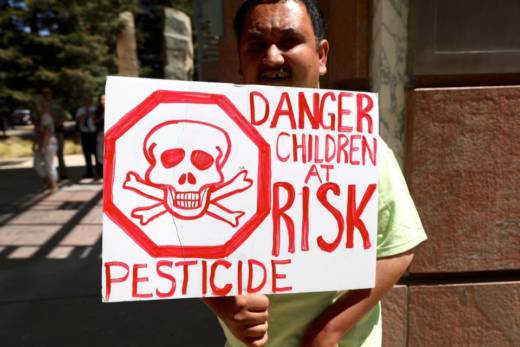Updated Thursday, Aug. 15: The nation’s most productive agricultural state has prohibited a widely used toxic pesticide blamed for harming brain development in babies, California officials said Wednesday. This is the first time the state has banned a pesticide outright.
California Bans Chlorpyrifos, Widely Used Pesticide

The move will outlaw chlorpyrifos (klohr-PY’-rih-fohs) after scientists deemed it a toxic air contaminant and discovered it to be more dangerous than previously thought. California Secretary for Environmental Protection Jared Blumenfeld said in May that it’s the first time the state has sought to ban a pesticide and that the move was overdue.
“This pesticide is a neurotoxin and it was first put on the market in 1965,” Blumenfeld said. “So it’s been on the shelf a long time and it’s past its sell-by date.”
The decision comes after regulators in several states have taken steps in recent years to restrict the pesticide that has been used on dozens of different crops in California, including grapes, almonds and oranges.
Hawaii has already banned chlorpyrifos and New York lawmakers recently sent a bill to its governor outlawing its use.
DowDuPont, which produces the pesticide, has criticized efforts to curtail its use and said it will hurt farmers who rely on it to control insects.
Blumenfeld said the state took action in part because the U.S. Environmental Protection Agency under President Donald Trump allowed chlorpyrifos to be used after the Obama administration tried to phase it out. The EPA reversed course on banning the pesticide in 2017, after re-evaluating the science. Blumenfeld criticized that decision.
“We’ve had enough evidence, the U.S. EPA and the Obama administration, to say it’s really time to take action,” Blumenfeld told KQED Science. “California is saying enough is enough. We need to take action to protect human health.”
The pesticide is also in jeopardy on the federal level. After environmental groups and farmworkers challenged the EPA’s reversal, a 9th Circuit judge ruled in their favor. The EPA appealed to the whole 9th Circuit, but again lost, and the court told the EPA to issue a new decision by July, based on the scientific record. California based its ban on that decision.
Chemically Similar to Nerve Gas
Chlorpyrifos is in a class of organophosphates chemically similar to a nerve gas developed by Nazi Germany before World War II. Its heavy use has often left traces in drinking water sources. A UC Berkeley study in 2012 found that 87% of umbilical-cord blood samples tested from newborn babies contained detectable levels of the pesticide.
Dr. Gina Solomon, a medical professor at UCSF and a former deputy secretary of Cal-EPA, said chlorpyrifos is unusual in that it’s one of the best understood pesticides because it’s been so extensively studied.
“We know a lot about what it does to developing children and that science is the bedrock of the action that Cal-EPA is announcing,” she said. “Many pesticides have been studied well in lab rats but in this case we actually know what it does to people.”
Studies in cities where the pesticide was once used to kill cockroaches before it was banned for indoor use in 2000, as well as research done in rural farmworker communities, showed that chlorpyrifos harmed brain development in fetuses and affected reading ability and IQ, Solomon said. “It also led to hyperactivity in children. Even head sizes were smaller in children whose mothers were exposed to the pesticide.
One area that’s less-well studied is the impact of the pesticide on people who consume produce that has a residue of the chemical on it. Solomon said with California growing the majority of fruits and vegetables in the country there could be a ripple benefit for consumers in other states.
In August 2018, a California-sponsored scientific review found that the pesticide poses serious health effects in children at levels lower than previously understood. In November, California regulators recommended new restrictions on the pesticide that included discontinuing its use on most crops.
While the ban — technically known as a cancellation — could take up to two years to take effect, the state Department of Pesticide Regulation has recommended that county agriculture commissioners adopt stricter rules on where and how the chemical can be applied, including larger buffer zones.
To help farmers make the transition away from chlorpyrifos, the state is adding a $5.7 million to fund safer alternatives.
The state’s decision Wednesday follows years of lobbying by environmentalists and farmworkers, who pushed California regulators to ban the insecticide, one of the most commonly used in the country.
Blumenfeld, who was confirmed as Gov. Gavin Newsom’s CalEPA head in March, said he’d like California to approach pesticides differently, by ending the practice of banning them only to replace them with something similarly toxic.
“We need to move to a place where we are using the innovative spirit that California has, to come up with alternatives that are safe and nontoxic,” he said. “Farmers are actually hurting out there. A great majority of fruits, nuts and vegetables grown in America are grown in California. With climate change, there are going to be more pests, different pests—pests aren’t going away, they will get worse. We need nontoxic alternatives.”
Kevin Stark and Molly Peterson of KQED contributed to this post.
